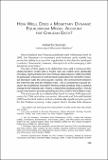Artículo
How well does a monetary dynamic equilibrium model account for chilean data?
Fecha
2005Resumen
Since Kydland and Prescott published their influential work in 1982, the literature on monetary real business cycle models has proved its ability to account for regularities in the data for developed countries. Few works, however, attempt to do so for emerging Latin American economies. The aim of this paper is to determine how well a money-in-theutility-function model with a Taylor rule can match some particular monetary stylized facts from the Chilean data between 1986 and 2000. In particular, it focuses on a theoretical explanation for what the empirical literature calls the price puzzle, namely, the comovement between the interest rate and the inflation rate. This is considered a puzzle because the traditional Mundell-Fleming model predicts that a positive change in the interest rate—that is, a restrictive monetary policy—should cause a decrease in private spending and thus a fall in the inflation rate.
Colecciones
Descargar


